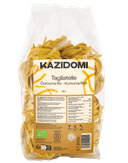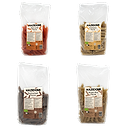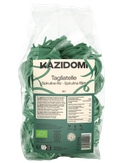Do you love pasta but gluten doesn’t agree with you? Good news: gluten-free alternatives are plentiful—and they’re just as delicious as traditional durum wheat pasta. Packed with flavor, often more digestible and nourishing, they’re now found on more and more plates, even among those who aren’t intolerant.
If you’re still hesitating, here’s why (and how) you should bring gluten-free pasta into your daily routine.
Why Eat Gluten-Free Pasta?
Once reserved for people with celiac disease, gluten-free pasta is now winning over a much wider audience—and it’s not just a passing trend.
First, they’re easier to digest. Many people experience discomfort after eating gluten, without being truly intolerant. Bloating, fatigue after meals, reactive skin… These often-overlooked signals can be eased by a diet that’s gentler on the body.
Second, these pasta varieties are often made from ingredients naturally rich in fiber, plant proteins, or minerals. While traditional pasta mostly delivers carbohydrates, some gluten-free alternatives check several nutritional boxes at once.
Finally, they’re easy to integrate into everyday meals. Available in organic versions, simple to cook, and compatible with all kinds of sauces and toppings, they work just as well for quick weekday dinners as for more elaborate dishes.
Which Pasta to Choose?
Not all gluten-free pasta is created equal, and each type has its own qualities. Here’s a quick guide to the main options worth stocking in your pantry:
Rice: The Safe Choice
Whole grain or brown rice pasta is the closest to regular pasta in texture and taste. Mild and neutral, it appeals to the whole family. Rice is naturally gluten-free, very digestible, and rich in magnesium in its whole form.
Buckwheat: Rustic and Filling
Buckwheat has nothing to do with wheat. It’s a naturally gluten-free pseudo-cereal, rich in antioxidants and plant proteins. Its stronger flavor makes it a great base for winter dishes or recipes with mushrooms, roasted vegetables, or plant-based cream.
Red Lentil: Protein-Rich
With its lovely orange hue, red lentil pasta is perfect for a change of pace. It’s particularly high in iron, fiber, and protein, and has a lower glycemic index than regular pasta. An excellent choice for vegetarians and athletes.
Chickpea: Highly Nourishing
Chickpea pasta delivers a serious dose of plant protein, with a slightly denser texture. They pair beautifully with homemade tomato sauce or a stir-fry of crunchy vegetables. As a bonus, they’re rich in B vitamins and manganese—two allies for energy.
How to Cook Them Well
If you’ve been disappointed by mushy or sticky gluten-free pasta, don’t worry: a few simple steps will help you get perfect results.
- Watch the cooking time: gluten-free pasta often cooks faster. Follow the instructions on the package, or even remove them a minute early for an al dente texture.
- Use plenty of water: gluten-free flours release more starch. A large volume of water reduces gumminess and improves texture.
- Drain well and add a drizzle of olive oil after cooking to keep them from sticking together, especially if you’re not serving them right away.
- Match sauces to pasta types: rice pasta works well with classics, while chickpea or red lentil pasta shine with grilled vegetables, nut purées, or mild spices.
Conclusion
Gluten-free pasta has more than one advantage: they’re tasty, nutrient-packed, and adapt to all diets. Whether you’re intolerant or simply curious, they deserve a real spot in your kitchen. Try different types, mix up your recipes, and have fun discovering new flavors—your digestion (and your taste buds) will thank you.








